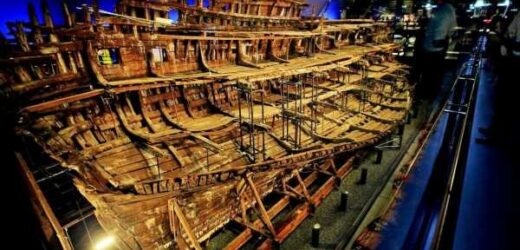King Charles attends raising of the Mary Rose in 1982
We use your sign-up to provide content in ways you’ve consented to and to improve our understanding of you. This may include adverts from us and 3rd parties based on our understanding. You can unsubscribe at any time. More info
The huge timbers of Henry VIII’s favourite vessel, expertly aligned when she was laid down in 1510 by Tudor ship-builders to state-of-the-art designs, are remarkably intact.
And thanks to millions of hours of painstaking conservation work, it is still possible to make out the decks of the mighty warship which draws tens of thousands of visitors each year.
In her purpose-built museum in Portsmouth’s Historic Dockyard, 21st-century technology brings the Mary Rose to life by projecting images of sailors loading cannons on to her surviving decks, while digital models reveal how she looked in her glory.
Yet, despite her enduring majesty, the Mary Rose is strangely incomplete without a discernible stern or bow to complete her risen form. What remains in their absence, however, is the mystery of why she sank. Now the answer to both could be within reach.
Experts believe locating and retrieving her sunken forecastle – the forward part of her superstructure – would be as momentous as the wreck’s original discovery.
Forget the myth the carrack-type vessel was so badly designed and top-heavy that she sank unmolested on her maiden voyage, in fact Henry VIII’s great warship had seen 33 years of stalwart service in several wars, against France, Scotland and Brittany.
When the 600-ton giant was originally built in 1510, she was one of the first ships with gun ports along her side, from which to fire six or eight large cannons, and at her stern and bow she boasted multiple wooden decked “castles” from which archers could harass enemy ships.

That is why, even today, the front deck of a ship is known as the fo’c’s’le or forecastle.
The Mary Rose’s appearance and reputation would have cheered Henry’s navy, and perturbed the enemy as a 225-strong French fleet – nearly twice the size of the Spanish Armada that would threaten England 43 years later – faced off against the English fleet in the Solent on July 19, 1545, ahead of a planned invasion.
King Henry himself watched expectantly from land at Southsea, a mile away, having inspected the fleet the day before. But as she moved forward to take on the French attackers, the Mary Rose was seen to heel to the right and sink rapidly – with just 35 survivors from her 500-strong crew.
She was the only major casualty of the confrontation, before the French invasion fleet retreated and today, 477 years later, experts believe the absence of the ship’s entire bow castle and the answer to her mystery sinking are one and the same.
“Anyone who comes into the Mary Rose museum will see she has a very blunt end because the huge bow castle is missing,” Dr Alexzandra Hildred tells the Daily Express. As head of research and curator of ordnance and human remains at the Mary Rose Trust, Dr Hildred knows probably more than anyone about the country’s greatest wreck.
Yet despite more than 40 years of work, she still is not sure what happened to the bow castle. It could have been badly damaged by Tudor salvage operations, French cannon fire, marine organisms or washed away by tidal action in the Solent, she admits.

But, tantalisingly, during diving work in 2003 and 2005, a chunk of the bow was identified before being reburied under the silt so that the ancient timbers would be less vulnerable to marine erosion until the necessary funding might be found to raise it.
Dr Hildred estimates it would cost £500,000 to bring up the section of the bow, already discovered, but the costs of conservation and finding other remains would bring this up to £1million. Nevertheless, if it could finally solve the mystery of the sinking it would be money well spent.
No cannon fire marks have been found on the timbers so far brought up to suggest catastrophic damage but Dr Hildred does have her hunches about what happened to the Mary Rose.
“My view is that there were a couple of hits below the waterline, which allowed water to enter the shingle ballast at the bottom,” she says. “That is my gut feeling, but this is still a big question. Maybe it heeled over and sank because of a problem with the bow structure.”
Evidence has emerged of cannons on the Mary Rose being loaded to fire, so it appears she had been involved in an exchange of fire with the French fleet or was ready to engage.
“What we know for certain is that she was found lying on her starboard side with her gun port lids open. Heeling to starboard without righting, with rig her open ports below the waterline, would have been enough to sink her,” she explains.
“We know a lot about the Mary Rose but there are a lot of questions which still need to be answered.”
One of the most pertinent is who would pay for what remains of the bow to be brought up? Money for the earlier exploration work came from the Ministry of Defence as there had been plans to gouge a huge channel into the Solent bed to make it deep enough for the nation’s gigantic aircraft carriers. That would have cut directly into the Mary Rose site, but those plans are on hold and the remaining site is safe for the time being.
The then Prince of Wales – now King Charles III – became President of the Mary Rose Trust in 1979, formed in part to bring the ship to the surface and preserve her for the nation, and had been a great supporter since his first dive there in 1975.
Looking young and fresh faced he watched from a boat when she was raised from the murky depths on a blustery morning on October 11, 1982, having completed his 10th dive to the wreck the day before.
Around 60 million watched on TV and thousands more jostled on Portsmouth harbour and along the waterfront as the ship was lifted from the seabed on a giant gantry.
Given the interest, Dr Hildred is hopeful support could be found to raise the bow timbers and there are plenty of divers willing to do the groundwork to make that dream happen. In fact, some of the 500 divers who took part in raising her have just visited the site to mark the 40th anniversary and the question on many of their lips was: What else is still down there to salvage?

Many of the 19,000 objects found – in what has been described as a “Tudor time capsule”, beautifully preserved in the thick muddy silt – can be seen at the museum, including cannons, tankards, plates, gold coins, wooden, bows and arrows and carpentry tools from a time which still fascinates the public.
The museum will soon have an added attraction. A 4D “cinema” is being installed in one gallery, which is aimed at giving visitors ao an immersive experience of what it was like to dive on the wreck. To add to the experience there will also be puffs of wind and chairs will move.
“It will make you feel as though you are diving on the Mary Rose site,” Dr Hildred promises.
“The Mary Rose is very much a story of endeavour and synchronicity. Even now, 40 years after the raising, underwater excavation has not been equalled in scale, nor the recovery in its complexity.”
And there are still plenty of new chapters to be written before the story is fully told.
Mary Rose: Her Story, Their Story, Our Story by Dr Alexzandra Hildred is available via maryrose.org priced £25.
Source: Read Full Article


